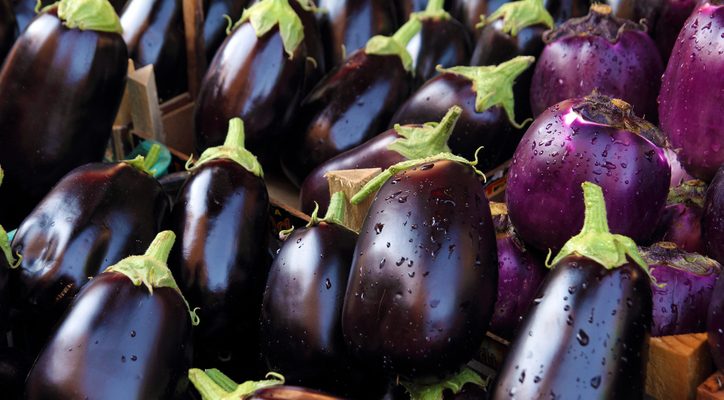
Is purple really the new green? Everyone always goes on and on about the latest fad diet and eating your greens, and while green vegetables are incredibly high in phytonutrients, purple vegetables are also very healthy for you.
Purple vegetables are a fast growing trend for 2017. As a holistic nutritionist, I often stock up on purple vegetables on a regular basis—and not just because they look interesting. The color purple from these foods often indicates a food high in nutrients, especially antioxidants known as anthocyanins. The health benefits of antioxidants in purple foods have long been known to fight cancer, reduce inflammation and improve skin health, lower the obesity rate, and improve brain and heart health. Let’s take a look at some of the top purple food that I will be using in 2017 and beyond.
- Kohlrabi: Kohlrabi (pronounced coal-ROB-ee) can be green, but it can also look purple. This vegetable tastes similar to a broccoli stem but sweeter and milder. Some may describe the taste as somewhere between a cabbage, jicama, and mild radish. Research shows that kohlrabi’s phytochemical content can ward of diabetes, cancer, and high cholesterol, while also improving kidney and liver function.
- Purple Sweet Potatoes: We all know sweet potatoes are a healthy carb and versatile root vegetable. What you may not know is sweet potatoes come in purple, too. These are also called Okinawan potatoes. They share a lot of the health benefits of orange potatoes, but they are also filled with anthocyanins that help with inflammation and digestion. Just be careful when you put them in soup, as your soup will be purple as well.
- Eggplant: You may know about eggplant, but what you may not know is that there are several eggplant varieties that are mostly purple, including Thai eggplants, Ping Tung Long eggplants, and the very decorative and ornamental Chinese round mauve eggplant. These eggplants look so nice that you may not even want to eat them. But you should because they are full of vitamin C, magnesium, potassium, and various B vitamins.
- Purple Cauliflower: Cauliflower is not just plain ol’ white; it also comes in orange, and purple, too. The anthocyanins in purple cauliflower are helpful for weight control and lowering your risk of heart disease, type 2 diabetes, and cancer. Other anti-cancer compounds in purple cauliflower include glucoraphanin, which breaks down to form sulforaphane.
- Purple Radishes: Although radishes can be red, there are all sorts of purple radish varieties like the purple daikon radish and the purple plum radish. The word daikon is actually Japanese for “great root.” It is likely viewed as great due to its high nutrient density. Purple plum radishes and daikon radishes are both exceptional sources of vitamin C, potassium, and magnesium.
- Purple Carrots: Before the 17th century, the majority of carrots cultivated were purple. The modern day orange carrot was actually not cultivated until Dutch growers in the late 16th century took strains of the purple carrot to gradually develop the variety of orange carrot that we have today. The orange carrot, although high in nutrients, does lack the purple pigment antioxidant of anthocyanin.
- Purple Cabbage: Although similar in flavor to green cabbage, red cabbage has a deep ruby-red to purple color in its outer leaves. The red cabbage also has more vitamin C than green cabbage. There are also varieties of nappa cabbage that look purple as well.
- Black Rice Risotto: Black rice was once described as forbidden only because it was produced on a much smaller scale than white or brown rice. That being said, black rice risotto has lots of benefits. For instance, it is high in iron and vitamin E and contains about six times more antioxidants than other forms of rice.
- Purple Asparagus: The purple asparagus was originally from Albenga, Italy. This form of asparagus is only available from spring to early summer. The purple color comes from the high anthocyanins levels in the spears of the vegetable. These anthocyanins are high in anti-cancer and anti-inflammatory properties.
- Acai Berries: Acai berries have become a popular superfood in recent years. This antioxidant-rich fruit aids in weight loss, lowers cholesterol, helps digestion, boosts the immune system, and promotes skin health overall. Brazilians have actually been eating acai berries to treat skin conditions for centuries.
Other Purple Foods You Should Consider
There are actually a lot of purple vegetables. It is also a good idea to fill your plate or bowl with other purple foods. Some other bluish-purple foods you may want to consider include the more common blackberries, blueberries, purple grapes, plums, prunes, raisins, dried plums, purple figs, black currants, beets, and purple corn. That being said, other not-so familiar purple foods include purple-fleshed potatoes, purple dandelion, black olives, elderberries, purple peppers, black salsify, and purple Belgian endive.
Sources:
De Graaf, M., “Purple Food Trend: 5 reasons this color is so good for you,” IOL website, Jan. 13, 2017; http://www.iol.co.za/lifestyle/food-drink/purple-food-trend–5-reasons-this-colour-is-so-good-for-you-7397981.
Freedman, J., “Start eating purple for good health: the science behind 2017’s new food trend,” The Telegraph website, Dec. 19, 2016; http://www.telegraph.co.uk/food-and-drink/news/start-eating-purple-good-health-science-behind-2017s-new-food/.
“Kohlrabi: A Disease-Fighting, Phytochemical Powerhouse,” Dr. Axe website; https://draxe.com/kohlrabi/, last accessed Jan. 13, 2017.
“Health Benefits of Eggplant,” Organic Facts website; https://www.organicfacts.net/health-benefits/vegetable/health-benefits-of-eggplant.html, last accessed Jan. 13, 2017.
“Nutrients of Purple Cauliflower,” SFGate website; http://healthyeating.sfgate.com/nutrients-purple-cauliflower-5633.html, last accessed Jan. 13, 2017.
“Purple Daikon radish,” Specialty Produce website; http://www.specialtyproduce.com/produce/Purple_Daikon_Radish_10538.php, last accessed Jan. 13, 2017.
“Carrots Used to be Purple Before the 17th Century,” Today I Found Out website; http://www.todayifoundout.com/index.php/2010/04/carrots-used-to-be-purple-before-the-17th-century/, last accessed Jan. 13, 2017.
“Types of Cabbage,” Berkeley Wellness website, Sept. 28, 2015; http://www.berkeleywellness.com/healthy-eating/food/article/types-cabbage.
“Purple Asparagus,” Specialty Produce website; http://www.specialtyproduce.com/produce/Purple_Asparagus_471.php, last accessed Jan. 13, 2017.
Group, E., “12 Health Benefits of Acai Berries,” Global Healing Center website, June 14, 2010; http://www.globalhealingcenter.com/natural-health/benefits-of-acai/, last accessed Jan. 13, 2017.













